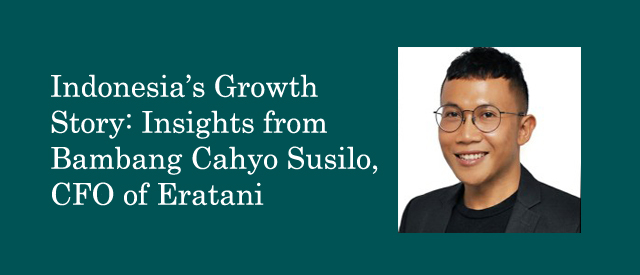Indonesia’s Growth Story: Insights from Bambang Cahyo Susilo, CFO of Eratani

Bambang was speaker in the in the INA-LAC Society Forum in Lima and discussed the entrepreneurial ecosystem in Indonesia. Eratani[1] is a company working empowering Indonesian farmers to fill the gap of food supply.
Why is the fintech ecosystem in Indonesia growing so quickly?
Essentially, there are three main challenges in Indonesia’s entrepreneurial ecosystem. First, there’s access to funding, particularly to smart capital, which is crucial for entrepreneurs. Second, there’s access to technology, knowledge, and the market. Third, a major challenge is access to talent.
Fortunately, Indonesia’s entrepreneurial ecosystem is becoming more vibrant. Many experienced entrepreneurs now serve as mentors and role models for the younger generation. These senior entrepreneurs are expanding their influence by acting as mentors and investors, guiding the new generation.
As a result, entrepreneurship in Indonesia is no longer a lonely journey. There’s growing support from private individuals and, increasingly, from the government as well. So, I think it’s the perfect time for these young entrepreneurs to scale their businesses, solve real problems, and create massive opportunities for job creation in Indonesia.
Do you think Indonesian city hubs are helping to foster talent?
Yes, we’ve seen different stages of entrepreneurship development over the years. In the beginning, from around 2012 to 2017, most entrepreneurs were centralized in Jakarta, the capital city. This was largely due to easier access to essential services. But now, we’re seeing interesting success stories proving that entrepreneurs can establish their companies in secondary cities.
For example, a well-known entrepreneur started a company while still at university in Bandung, the second largest city, and today, it has become the largest aquaculture business in Southeast Asia. This success validates that entrepreneurs can identify and solve problems in their hometowns and then scale up to serve the nation or even the international market.
While company headquarters can remain in provincial areas, a presence in Jakarta is often necessary. The reason is access to talent—most of which is typically found in larger cities, right?
Regarding your experience in the agriculture business with Eratani, how can start-ups contribute to solving real problems?
Indonesia is home to more than 275 million people, and we eat rice three times a day, right? With a population growth rate of 8% and a median age of 30 years, our population is growing. The increasing demand associated with this growth must be supported by a reliable food supply, but the problem is that the supply is not ready yet. That’s why imports are critically needed, while Indonesia needs to solve its internal supply issues.
Eratani validates the importance of securing the national food supply. So, what can be done to foster this kind of solution? First, we focus on supply, which means working directly with farmers to ensure reliable sources. In other words, we really need to find solutions to address the major pinpoints faced by farmers in Indonesia. That’s why Eratani employs technological solutions and facilitates access to markets.
I believe Eratani is no longer just a single player because many stakeholders are also helping us—governments, the private sector, and NGOs. This is no longer just start-up homework; it’s a collective movement involving various stakeholders related to the agriculture sector.
Finally, what do you recommend to this new generation of young entrepreneurs in Peru? Particularly, what opportunities can entrepreneurs find in the coffee sector?
Ten years ago, coffee culture was typically associated with older generations, but now it’s expanding among younger populations with a twist—not just black coffee, but a variety of flavored options.
The challenge is how to penetrate this massive demand for coffee across various segments. For example, we have specialty coffee aimed at those who truly appreciate a high-quality brew. At the same time, there’s a larger population of young people who enjoy more affordable coffee with unique twists. Companies like Kopi Kenangan are among the largest players in this sector, but there are also many smaller competitors, making the market increasingly crowded.
So, what are the participation and opportunities for young entrepreneurs in the coffee sector in Peru? I think it’s essential to look at the field holistically. Competing in the Indonesian market requires local knowledge, insights, and understanding. The competition can be tough, but there are also opportunities for innovation.
For instance, Colombian coffee is more expensive in Indonesia and other parts of the world. The challenge is to determine what added-value products can be sold from Latin America to Indonesia. This means not just selling raw beans, but also processed coffee products, which could create significant opportunities.